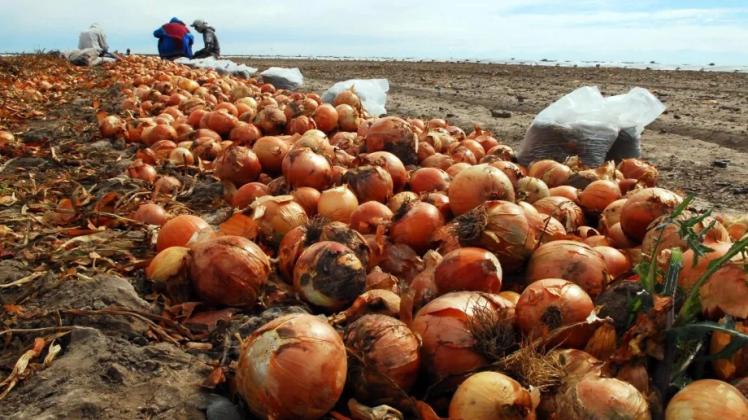Argentina (Río Negro): Onion exports are suspended
"By the same date last year, 30% of the total volume had been allocated for export. This year, however, we only reached 20%."

"What happened is that in 2024, exports were extended until the end of June, but this time, shipments practically stopped on May 31," explained Lucio Reinoso, Secretary of Agriculture of Río Negro.
Demand for Argentine onions, especially those from Río Negro, fluctuates depending on weather events that impact production during the peak demand window, which runs from March to May. Last season, the weather in Brazil was very favorable, resulting in excellent yields in both the south and center of the country. This significantly narrowed the demand window, resulting in fewer shipments compared to the average in previous years.
The devaluation of the Brazilian real, which had been a source of concern among producers since the summer, was recently compounded by a large supply of onions in the neighboring market. “Since June, we have observed a notable decrease in demand for onions from Brazil, which heralds the end of the export season. This season, which began in March, has seen little activity compared to the previous one, which was a record-breaking one, although there was a slight upturn in sales during the first three weeks of May,” warned the Río Negro Department of Agriculture.
Onion marketing in southern Argentina, especially in Río Negro, begins every January with early onions and continues until September with "late" or "storage" onions. The latter are in demand on the external market, peaking in April, May, and June, a period that coincides with a lower onion supply from the main importing country. During this time, the sale of onions harvested in Santa Catarina (which are sold in Brazil from November to May) concludes, and the onion harvest in the Central region (Minas Gerais, Goiás) has not yet begun.
Experts indicate that in Brazil, onions are a product with inelastic demand, meaning their consumption does not vary significantly with price fluctuations. Furthermore, Brazil produces an annual volume that approximates its domestic demand, approximately 1,500,000 tons. However, unlike Argentine production, which is fairly stable, Brazilian onion yields experience significant fluctuations due to weather events that cause losses. However, this season there were no weather complications, and demand for onions from Brazil decreased significantly in June.
The decline in Brazilian demand comes just as the onion harvest in Minas Gerais and São Paulo is beginning, which this year has yielded good volume and quality. This makes it difficult to compete with local prices. "With the start of the harvest in the central region, the marketing season for Argentine onions in Brazil ends," warns the Río Negro Department of Agriculture.
It should be noted that onion prices are governed by the law of supply and demand. This season, raw onion prices began with "bucket" prices ranging between 25 and 35 pesos per kilo, remaining relatively constant, with a slight increase during the first weeks of May.
Between January 1 and May 31 of this year, Río Negro issued plant transit documents (DTV-e) for onions totaling 113,229 tons. With 7,800 hectares of onions planted in the province last season, it is estimated that approximately 50% of the production has been sold so far. "Of the total amount sold so far, 50% is destined for export and 50% for the domestic market," Reinoso adds.
Comparing shipments made so far, it can be seen that at the same time last year, more than 85,000 tons were shipped, while this year, 54,800 tons were shipped.
The planted area in 2024 was reduced to 6,890 hectares, compared to 7,800 hectares for the current season. However, last season set records for both demand and prices in Brazil.
Reinoso emphasizes: "Although onion cultivation has become the most important vegetable crop in Río Negro (due to its area and added value), it is crucial to implement concrete measures to address the constant fluctuations in onion prices in order to ensure the sustainability of the activity."
Brazil accounts for 90% of Argentine exports, although demand from that country is decreasing each year due to the incorporation of technology that allows for better results. “Relying on a single client or market, even if initially profitable, represents a considerable risk. It is essential to diversify the export market to other countries. We believe that a better understanding of the markets and the factors that affect future demand for this vegetable will allow producers to make decisions about planted areas and future expectations based on solid foundations,” Reinoso adds.
Last March, the provinces of Río Negro and Buenos Aires, together with municipalities and the National Institute of Technology (INTA), organized the 26th Mercosur Onion Seminar, focused on improving competitiveness and exploring new international markets. “Latin American and global markets were examined. It’s not an easy task, especially given logistics costs, but it’s the way forward. Local production models need to become increasingly efficient in the use of resources and in the yields and quality obtained, in order to minimize the cost per kilo of product obtained,” Reinoso concluded.
Fuente:









